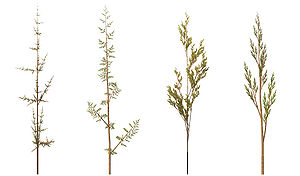
Aristid Lindenmayer
Encyclopedia
Aristid Lindenmayer was a Hungarian
biologist
. In 1968 he developed a formal language
that is today called L-system
s or Lindenmayer Systems. Using those systems Lindenmayer modelled the behaviour of cells of plants. L-systems nowadays are also used to model whole plants.
 Lindenmayer worked with yeast
Lindenmayer worked with yeast
and filamentous fungi and studied the growth patterns of various types of algae, such as the blue/green bacteria Anabaena catenula
. Originally the L-systems were devised to provide a formal description of the development of such simple multicellular organisms, and to illustrate the neighbourhood relationships between plant cells. Later on, this system was extended to describe higher plants and complex branching structures.
Hungary
Hungary , officially the Republic of Hungary , is a landlocked country in Central Europe. It is situated in the Carpathian Basin and is bordered by Slovakia to the north, Ukraine and Romania to the east, Serbia and Croatia to the south, Slovenia to the southwest and Austria to the west. The...
biologist
Biologist
A biologist is a scientist devoted to and producing results in biology through the study of life. Typically biologists study organisms and their relationship to their environment. Biologists involved in basic research attempt to discover underlying mechanisms that govern how organisms work...
. In 1968 he developed a formal language
Formal language
A formal language is a set of words—that is, finite strings of letters, symbols, or tokens that are defined in the language. The set from which these letters are taken is the alphabet over which the language is defined. A formal language is often defined by means of a formal grammar...
that is today called L-system
L-system
An L-system or Lindenmayer system is a parallel rewriting system, namely a variant of a formal grammar, most famously used to model the growth processes of plant development, but also able to model the morphology of a variety of organisms...
s or Lindenmayer Systems. Using those systems Lindenmayer modelled the behaviour of cells of plants. L-systems nowadays are also used to model whole plants.

Yeast
Yeasts are eukaryotic micro-organisms classified in the kingdom Fungi, with 1,500 species currently described estimated to be only 1% of all fungal species. Most reproduce asexually by mitosis, and many do so by an asymmetric division process called budding...
and filamentous fungi and studied the growth patterns of various types of algae, such as the blue/green bacteria Anabaena catenula
Anabaena
Anabaena is a genus of filamentous cyanobacteria that exists as plankton. It is known for its nitrogen fixing abilities, and they form symbiotic relationships with certain plants, such as the mosquito fern. They are one of four genera of cyanobacteria that produce neurotoxins, which are harmful to...
. Originally the L-systems were devised to provide a formal description of the development of such simple multicellular organisms, and to illustrate the neighbourhood relationships between plant cells. Later on, this system was extended to describe higher plants and complex branching structures.
Publications
- Aristid Lindenmayer, "Mathematical models for cellular interaction in development." J. Theoret. Biology, 18:280—315, 1968. (available as a PDF)
- Further publications

